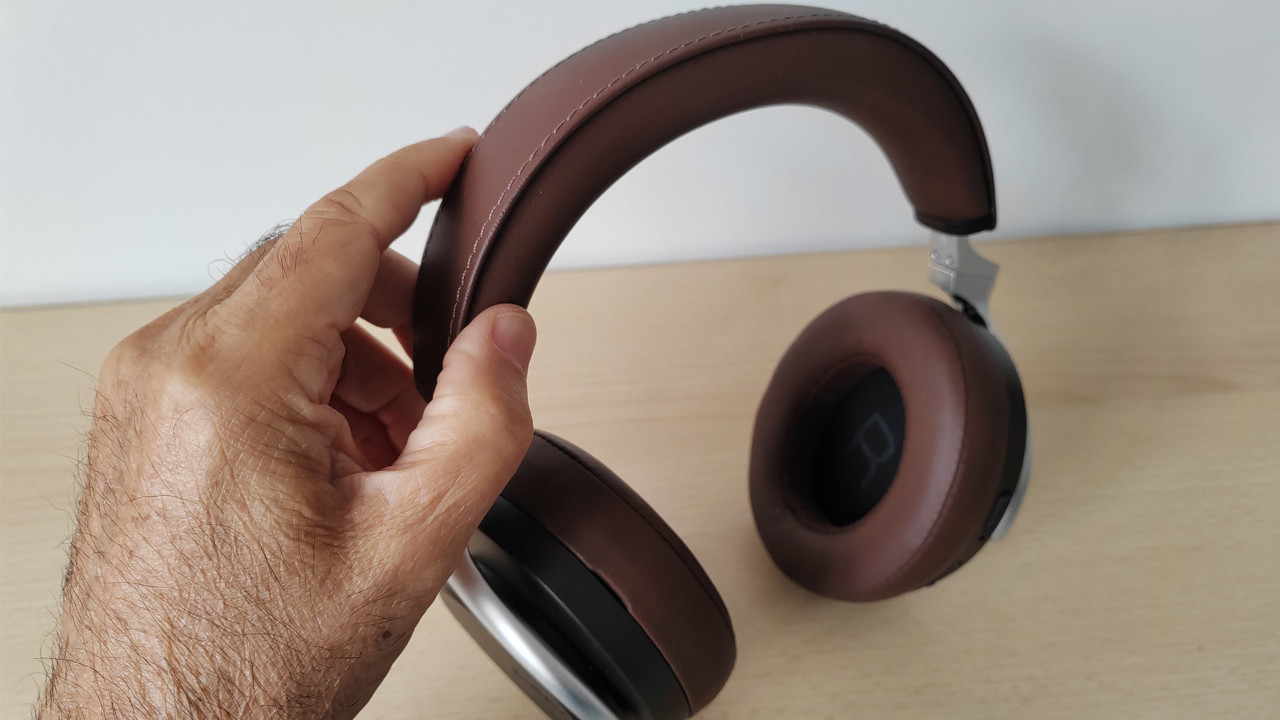Louder Verdict
The Aonic 50 are stunning headphones. The design and finish is top notch, they’re comfortable to wear, and their balanced performance will have the most demanding audiophiles smiling. However, they don’t have the battery stamina of prestige rivals and they don't fold for travel purposes. But if you can live with such foibles, you’ll sure as heck enjoy wearing them.
Pros
- +
Fabulous build quality
- +
Deep, tight bass
Cons
- -
Rivals' battery life better
- -
They don’t fold
You can trust Louder
If you’re after a premium pair of noise cancelling over-ear headphones, the Shure Aonic 50 fit the bill. A leather-padded headband with stylised stitching and matching ear pads, exude style. The weighty build at 334g might seem a concern but they're comfortable even during the longest jam sessions.
Audio performance is excellent, with tight bass, plenty of toppy detail and a melodious mid-range. Noise cancelling is entirely satisfactory although not quite as efficient as some rival brands. Battery life hits 20 hours with ANC engaged, which is down 10 hours compared to rival models, and Google Assistant is just a button press away. Bluetooth 5.0 supports aptX and aptXHD.
Overall, usability is good with intuitive physical controls for volume, pairing and noise cancelling modes. One quirk of the design is that while the Aonic 50 fold flat, they don’t hinge into a compact ball so travelling with them is a bit of a challenge.
Let's break it all down...
Shure Aonic 50 review: Design
In many ways, the Shure Aonic 50 are love at first sight. The leather padded headband with stylised stitching and generously padded ear pads, are very rock‘n’roll.
The earpad hinge swivels flat for storage but they don’t fold down (as evidenced by their platter-style storage case). Rival headphones with a pivoting hinge can be stowed in a smaller space. This makes the Shure Aonic 50 something of a challenge to travel with. By way of compensation, the ear pads are removable, which makes them easy to clean or replace.
They Shure Aonic 50 are relatively heavy at 334g, but they're still comfortable enough to wear for prolonged periods and have minimal clamping force. Available in black, brown or white, the pads are nicely matched to the cups.
The latest news, features and interviews direct to your inbox, from the global home of alternative music.
In addition to the large carry case, they come with a 3.5mm and USB-C cables.
Shure Aonic 50 review: Features

Control comes via a crescent of physical buttons on the right ear pad, where you’ll find volume, Bluetooth pairing and transport controls. Active Noise Cancelling is activated by a slider. It’s either on, in neutral or in Environmental mode, which is basically a transparency mode which allows you to hear ambient noise.
Double pressing the power button gives a spoken confirmation of battery life. Bluetooth is 5.0 and there’s support for a variety of codecs including aptX, hi-res aptXHD, aptX Low latency (to combat lip sync), SBC, AAC and LDAC. There’s also Bluetooth multipoint which allows two devices to connect simultaneously. Battery life is rated at 20 hours with ANC on.
Pressing a raised button on the power rocker calls up Google Assistant on the connected smartphone, which is handy if you need to ask for the location of the nearest dive bar.
You’ll want to use the Shure Aonic 50 with the accompanying ShurePlus app for iOS and Android. Through this you'll be able to update firmware, play media and access EQ presets, although these only apply to tracks played through the app.
Noise cancelling is good enough, helped by the passive isolation the thick ear pads offer. It’s powerful enough to mute general hubbub from the outside world. The Shure Aonic 50 charge over USB-C via the right ear cup.
Shure Aonic 50 review: Sound
I'd describe the sound profile of Shure Aonic 50 as balanced, with impressive resolution and a melodious mid-range. I love the timbre of Jon Lord’s organ on Deep Purple’s Might Just Take Your Life from the 2004 remaster of Burn. The solo sounds fresh and urgent, with layers of electronic nuance. Musicality is excellent; Maneskin’s Gossip sounds tighter than a Lamé jumpsuit. There’s no fizz or fuzz at volume.
The headphones also have excellent bass response. Not over-emphasised, it’s deep and resonant. Low blows hit with impressive accuracy and when the bodies hit the floor, they land with an impressive thud. The variable noise cancelling mode actually has quite a pronounced effect on the soundstage.
I actually prefer the Shure Aonic 50 with noise cancelling set to Max, not only when out and about, but during quiet room listening. In its Neutral position, there’s slightly more treble clarity but the sound becomes agreeably heavier with noise cancellation is its top position, which suits me fine.
Much of their signature sound can be traced to the substantial 50mm dynamic drivers in play. That angry guitar at the start of Corey Taylor’s Talk Sick is like a punky drill to the side of the head. It’s sharp and solid, exactly what you want from a good pair of headphones.
Shure Aonic 50 review: The alternatives
The Shure Aonic 50 have their work cut out at the higher end of the headphone market. Their most obvious competition comes from the Bowers & Wilkins PX7 S2, which have a comparably classy finish, and are a tad lighter. They’re also hi-res capable, work with Google Assistant and steal an edge when it comes to battery life, typically offering around 30 hours. However they have slightly small drivers (40mm), and don’t sound quite so sonically forward as the Aonic 50.
You can save even more cash if you opt for the JBL Tour Mk2. These excellent noise cancelling headphones are sublime all-rounders; exciting to listen to and a joy to wear. Once again battery life is better at 30 hours, but they can’t quite compete with the hefty bass extension offered by the Aonic 50s.
Related guides
- Cut the cord for less with the best budget wireless headphones
- Our pick of the best AirPods alternatives
- The best audiophile headphones: Get more from your music
- Get your hands on the best headphones under £100
- The best headphone amps to boost your listening
- Best Marshall headphones: Our pick of the bunch
Steve is a home entertainment technology specialist who contributes to a variety of UK websites and mags, including Louder Sound, Yahoo UK, Trusted Reviews, T3, The Luxe Review and Home Cinema Choice. Steve began his career as a music journo, writing for legendary rock weekly Sounds, under the nom de plume Steve Keaton. His coverage of post punk music was cited in the 2015 British Library exhibition Terror and Wonder: The Gothic Imagination, as a seminal influence on the Goth music scene.


